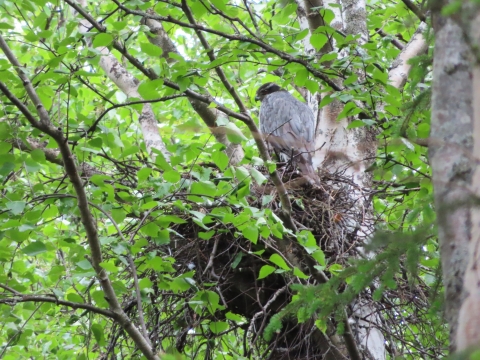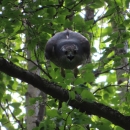States
AlaskaEcosystem
ForestOverview
American Goshawks are one of North America’s most elusive birds of prey. Goshawk ecology has been studied thoroughly across many parts of their range, but little is understood about their ecology and life history in the Alaska. On Joint Base Elmendorf-Richardson (JBER), located north of Anchorage, there have been preliminary surveys for American goshawk nests in recent years but there lacked any comprehensive study to understand their ecology. JBER is home to multiple airfields where bird aircraft strike hazard (BASH) are a concern and managers on JBER wanted to learn about goshawk abundance, distribution, and nesting ecology in the area. In response to those concerns, the USFWS, in partnership with JBER Biologists, began a study to assess the abundance, distribution, and ecology of these raptors as well as to understand the BASH that goshawks pose on the base.
Specifically, this project has the following objectives:
- Locate American goshawk nesting areas;
- Determine occupancy, nest success, and productivity at American goshawk nests;
- Describe American goshawk nesting habitat.
Importance of this Work
American goshawks are elusive because they inhabit dense forest stands for nesting, not often seen outside of those forests except when hunting or migrating. Once a nesting site is established by a goshawk, they may keep that territory for years. Their apparent preferences for forests dense canopy and open understory play a role in their distribution and abundance throughout the state. Because of their strict preferences, goshawks are sensitive to change. Human development, disturbance or forest clearing can disrupt goshawks, forcing them to move elsewhere to find suitable nesting territories. With an already limited understanding of these raptor’s movements and life history, monitoring efforts will continue to help us learn about goshawks and their habits, and in turn, will aid in further conservation and managing efforts.
Actions WE ALL can take
Participating in citizen science. American goshawks are elusive raptors that can be hard to find, even for biologists. Reporting goshawk sightings through programs like eBird can help biologists track goshawk movements and highlight areas where multiple sightings are recorded. Observations by the public provide information over time and can be useful for highlighting potential nesting habitat and places to search for nesting goshawks. These observations are useful for delineating areas for surveys, as well as help characterize what optimal habitat may look like.







